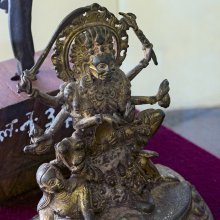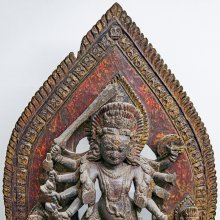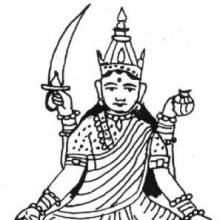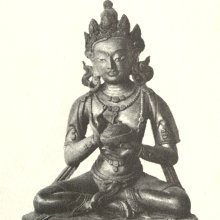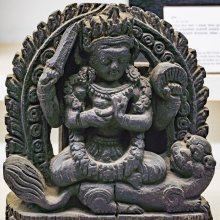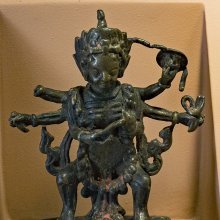Camunda, Cāmuṇḍā: 35 definitions
Introduction:
Camunda means something in Buddhism, Pali, Hinduism, Sanskrit, Jainism, Prakrit, the history of ancient India. If you want to know the exact meaning, history, etymology or English translation of this term then check out the descriptions on this page. Add your comment or reference to a book if you want to contribute to this summary article.
Alternative spellings of this word include Chamunda.
Images (photo gallery)
(+2 more images available)
In Hinduism
Shaktism (Shakta philosophy)
Source: Wisdom Library: Śāktism1) Cāmūṇḍā (चामूण्डा) refers to the seventh of the eight Aṣṭamātṛkā (mother Goddesses) of Kathmandu city, locally known as Kaṅga Ajimā or Kaṅkeśvarī. Her location is Kaṅkeśvarī (at Viṣṇumatī River bank).
2) Cāmūṇḍā (चामूण्डा) is an epithet of Kālī but used to invoke the goddess Durgā in her warrior mode during tantric rituals. Like Kālī, she is worshipped in a circuit (āvaraṇa) of ferocious female deities. Sacrifices are made to appease each of the directions where these deities hover. The identity of the goddess transforms at this stage of the rite, so that her willful and untameable properties start to take over.
3) Cāmuṇḍā (चामुण्डा):—Name of one of the sixty-four mātṛs to be worshipped during Āvaraṇapūjā (“Worship of the Circuit of Goddesses”, or “Durgā’s Retinue”), according to the Durgāpūjātattva. They should be worshipped with either the five upācāras or perfume and flowers.
Her mantra is as follows:
Source: Google Books: Manthanabhairavatantramॐ चामुण्डायै नमः
oṃ cāmuṇḍāyai namaḥ.
1) Cāmuṇḍā (चामुण्डा) is the name of a Mātṛkā (‘mother’) and is identified with the sacred site of Ekāmra, according to the Manthānabhairavatantra, a vast sprawling work that belongs to a corpus of Tantric texts concerned with the worship of the goddess Kubjikā.—According to the Kubjikā Tantras, the eight major Kaula sacred sites each have a house occupied by a woman of low caste who is identified with a Mother (Mātṛkā).—[...] Ekāmra is identified with (a) the class of sculptress (śilpinī) [or bone crusher woman (asthi-vidāriṇī)], (b) the Mātṛkā or ‘mother’ named Cāmuṇḍā, and (c) with the place of power (śaktisthāna).
2) Cāmuṇḍā (चामुण्डा) (or Jālā, Siddhayoginī) is the Goddess associated with Jālandhara, one of the sacred seats (pīṭha), according to the Manthānabhairavatantra.—Note: We observe that the Goddess in each seat is a Śavarī and the god a Śavara. The Śavaras are one of a number of tribes who are commonly associated with the deities, major and minor, in many Tantric traditions of this sort, both Śaiva and Buddhist. Implicit in these associations is that these deities [i.e., Cāmuṇḍā], in this case those of the sacred seats, are related to tribal ones.
Source: Sreenivasarao's blog: Saptamatrka (part 4)Camunda refers to one of the seven mother-like goddesses (Matrika).—Camunda represents the principal feminine force. The order of the Saptamatrka usually begins with Brahmi symbolizing creation. Then, Vaishnavi, Maheshvari, Kaumari, Varahi and Indrani. Then, Camunda is the destroyer of delusions and evil tendencies, paving way for spiritual awakening. The most important significance of Saptamatrka symbolism is the implication of the cyclical universal time and its cessation. In the standard versions, the cycle of periodic time ends with dissolution symbolized by Camunda. Camunda is also known as Camundi and Carcika.
Camunda is the destructive form of Devi (Candi); and is similar in appearance and habits to Kali. Devi Mahatmya recounts that in the course of her fight with demons Canda and Munda, Devi created from her forehead the terrible form of Camunda. Unlike other Matrikas, Camunda is an independent goddess. She is also praised as the fertility goddess of Vindhya Mountains She is also associated with Yama. The descriptions of Camunda are varied.
Source: Kamakoti Mandali: The Yoginis of Narasimha VyuhaCāmuṇḍā (चामुण्डा) is the name of a Mātṛkā-Śakti created by Mahārudra in order to control the plague of demons created by Andhakāsura.—Accordingly, Andhaka-Asura tried to kidnap Umā (Devī Pārvatī), and was fiercely attacked by Mahārudra who shot arrows at him from his mahāpināka. when the arrows pierced the body of Andhakāsura, drops of blood fell to earth and from those drops, thousands of Andhakas arose. To control this plague of demons, Mahārudra created Mātṛkā-Śaktis [viz., Cāmuṇḍā] and ordered them to drink the blood of the demons and drain them dry.
Source: Kamakoti Mandali: Nrisimha matrika-mandalaCāmuṇḍā (चामुण्डा) refers to one of the various Mātṛkā-Śaktis created by Rudra in order to destroy the clones that spawned from Andhaka’s body.—Accordingly, [...] Andhakāsura attempted to abduct Girājanandinī (Pārvatī) and thus ensued a fierce battle between Andhakāsura and the great Rudra, the Lord of Umā. Like raktabīja, every drop of blood that fell from the body of Andhaka created another Asura like him and in no time, the entire world was filled with Andhakas. To destroy the growing number of Andhakas, Rudra created innumerable Mātṛkā-Śaktis [viz., Cāmuṇḍā]. These Śaktis of immense power at once began to drink every drop of blood that flowed from the body of Andhaka, but they could still not effectively contain the emergence of more and more demons.
Source: Brill: Śaivism and the Tantric Traditions (shaktism)Cāmuṇḍā (चामुण्डा) is the name of a Goddess to be worshiped (to be worshiped in the branch of a bilva tree), as part of the Navarātra Tantric ritual (an autumnal festival of the warrior goddess Caṇḍikā).—The sixth (ṣaṣṭhī) and the seventh (saptamī) lunar days involve awakening the goddess in a bilva tree (bodhana), worship of goddess as Cāmuṇḍā and Kālī in the branch, summoning her nine radiations in nine leaves (navapatrapūjā/patrikāpūjā), enlivening an unfired clay image of the goddess (prāṇapratiṣṭhā).—Various 8th century sources refer to rituals such as the worship of Cāmuṇḍā, for example: Devīpurāṇa, Kālikāpurāṇa, Kṛtyakalpataru, Durgābhaktitaraṅgiṇī, Durgāpūjātattva, Durgāpūjāviveka, Bhadrakālīmantravidhiprakaraṇa in Sanderson (2007); account of the Durgā Pūjā in Kelomal, West Bengal (Nicholas 2013).

Shakta (शाक्त, śākta) or Shaktism (śāktism) represents a tradition of Hinduism where the Goddess (Devi) is revered and worshipped. Shakta literature includes a range of scriptures, including various Agamas and Tantras, although its roots may be traced back to the Vedas.
Shaivism (Shaiva philosophy)
Source: Wisdom Library: Kubjikāmata-tantraCāmuṇḍā (चामुण्डा):—Sanskrit name of one of the twenty-four goddesses of the Sūryamaṇḍala (first maṇḍala of the Khecarīcakra) according to the kubjikāmata-tantra. The Khecarīcakra is the fifth cakra (‘internal mystic center’) of the five (pañcacakra) and is located on or above the head. She presides over the pītha (‘sacred site’) called Puṇḍravardhana.
Source: academia.edu: Yakṣiṇī-sādhana in the Kakṣapuṭa tantraCāmuṇḍā (चामुण्डा) is the name of one of the thirty-two Yakṣiṇīs mentioned in the Kakṣapuṭatantra. In the yakṣiṇī-sādhana, the Yakṣiṇī is regarded as the guardian spirit who provides worldly benefits to the practitioner. The Yakṣiṇī (e.g., Cāmuṇḍā) provides, inter alia, daily food, clothing and money, tells the future, and bestows a long life, but she seldom becomes a partner in sexual practices.
Source: academia.edu: A Critical Study of the Vajraḍākamahātantrarāja (II) (shaivism)Cāmuṇḍā (चामुण्डा) is the name of a Goddess (Devī) presiding over Puṇḍravardhana: one of the twenty-four sacred districts mentioned in the Kubjikāmatatantra (chapter 22). Her weapon is the khaṭvāṅga. Furthermore, Cāmuṇḍā is accompanied by the Kṣetrapāla (field-protector) named Kumbhaka. A similar system appears in the 9th century Vajraḍākatantra (chapter 18).

Shaiva (शैव, śaiva) or Shaivism (śaivism) represents a tradition of Hinduism worshiping Shiva as the supreme being. Closely related to Shaktism, Shaiva literature includes a range of scriptures, including Tantras, while the root of this tradition may be traced back to the ancient Vedas.
Purana and Itihasa (epic history)
Source: Wisdom Library: The Matsya-purāṇaCāmuṇḍā (चामुण्डा) is the name of a mind-born ‘divine mother’ (mātṛ), created for the purpose of drinking the blood of the Andhaka demons, according to the Matsya-purāṇa 179.8. The Andhaka demons spawned out of every drop of blood spilled from the original Andhakāsura (Andhaka-demon). According to the Matsya-purāṇa 179.35, “Most terrible they (e.g., Cāmuṇḍā) all drank the blood of those Andhakas and become exceedingly satiated.”
The Matsyapurāṇa is categorised as a Mahāpurāṇa, and was originally composed of 20,000 metrical verses, dating from the 1st-millennium BCE. The narrator is Matsya, one of the ten major avatars of Viṣṇu.
Source: Wisdom Library: Varāha-purāṇaCāmuṇḍā (चामुण्डा) is a name of the Goddess Raudrī since she killed the asura king Ruru by severing his head (muṇḍa) from his trunk (carma), according to the Varāhapurāṇa chapter 96. Raudrī is the form of Trikalā having a black body representing the energy of Maheśvara (Śiva). Trikalā is the name of a Goddess born from the combined looks of Brahmā, Viṣṇu and Maheśvara (Śiva).
The Varāhapurāṇa is categorised as a Mahāpurāṇa, and was originally composed of 24,000 metrical verses, possibly originating from before the 10th century. It is composed of two parts and Sūta is the main narrator.
Source: archive.org: Puranic EncyclopediaCāmuṇḍā (चामुण्डा).—(See Pārvatī).
Source: archive.org: Shiva Purana - English Translation1) Cāmuṇḍā (चामुण्डा) is another name for Śivā: the Goddess-counterpart of Śiva who incarnated first as Satī and then Pārvatī, according to the Śivapurāṇa 2.1.16:—“[...] the great goddess Śivā is of the three natures. Śivā became Satī and Śiva married her. At the sacrifice of her father she cast off her body which she did not take again and went back to her own region. Śivā incarnated as Pārvatī at the request of the Devas. It was after performing a severe penance that she could attain Śiva again. Śivā came to be called by various names [such as Cāmuṇḍā,...]. These various names confer worldly pleasures and salvation according to qualities and action. The name Pārvatī is very common.
2) Cāmuṇḍā (चामुण्डा) refers to one of the “nine Durgās” (Navadurgā), participating in Vīrabhadra campaign against Dakṣa, according to the Śivapurāṇa 2.2.33. Accordingly, as Brahmā narrated to Nārada:—“Mahākālī went ahead for the destruction of Dakṣa accompanied by nine Durgās [viz., Cāmuṇḍā]. Eager in executing the command of Śiva, they accompanied the marching heroes—Ḍākinī, Śākinī, Bhūtas, Pramathas, Guhyakas, Kūṣmāṇḍas, Parpaṭas, Caṭakas, Brahma-Rākṣasas, Bhairavas and Kṣetrapālas and set out quickly for the destruction of Dakṣa’s sacrifice”.
Source: Cologne Digital Sanskrit Dictionaries: The Purana Index1a) Cāmuṇḍā (चामुण्डा).—A Śakti on the 9th parva of Cakrarājaratha.*
- * Brahmāṇḍa-purāṇa IV. 19. 7; 36. 58; 44. 87 and 111.
1b) A mind-born mother; image of, clothed in elephant skin.*
- * Matsya-purāṇa 179. 10; 261. 37.

The Purana (पुराण, purāṇas) refers to Sanskrit literature preserving ancient India’s vast cultural history, including historical legends, religious ceremonies, various arts and sciences. The eighteen mahapuranas total over 400,000 shlokas (metrical couplets) and date to at least several centuries BCE.
Vastushastra (architecture)
Source: Shodhganga: Temples of Salem region Up to 1336 ADCāmuṇḍā (चामुण्डा).—An aspect of Durga in the posture of killing the demons Caṇḍa and Muṇḍa, according to the Purāṇas is called by the name Cāmuṇḍā. Generally only one body of the demon is carved at the feet of the Goddess.
In saptamātṛka group Cāmuṇḍā is not represented in the samhāra posture. She is just represented as sitting in the sukhāsana on a pedestal or in utkuṛitāsana. Of the three sculptures under discussion, two are from the saptamātṛka group and one is an independent relief of the goddess in the samhāra posture. She is eight-handed. The demon is lying below the feet of the goddess. There is a flame like kirīta for the goddess.

Vastushastra (वास्तुशास्त्र, vāstuśāstra) refers to the ancient Indian science (shastra) of architecture (vastu), dealing with topics such architecture, sculpture, town-building, fort building and various other constructions. Vastu also deals with the philosophy of the architectural relation with the cosmic universe.
Natyashastra (theatrics and dramaturgy)
Source: Wisdom Library: SaṅgītaśiromaṇiCāmuṇḍā (चामुण्डा) refers to a particular form of Durgā and is the presiding deity of sucitra (‘extremely diverse’), according to the Saṅgītaśiromaṇi 67-84. Sucitra represents one of the sixteen words that together make up the elā musical composition (prabandha). Elā is an important subgenre of song and was regarded as an auspicious and important prabandha (composition) in ancient Indian music (gāndharva). According to nirukta analysis, the etymological meaning of elā can be explained as follows: a represents Viṣṇu, i represents Kāmadeva, la represents Lakṣmī.
Cāmuṇḍā is one of the sixteen deities presiding over the corresponding sixteen words of the elā-prabandha, all of which are defined in the Saṅgītaśiromaṇi (“crest-jewel of music”): a 15th-century Sanskrit work on Indian musicology (gāndharvaśāstra).

Natyashastra (नाट्यशास्त्र, nāṭyaśāstra) refers to both the ancient Indian tradition (shastra) of performing arts, (natya—theatrics, drama, dance, music), as well as the name of a Sanskrit work dealing with these subjects. It also teaches the rules for composing Dramatic plays (nataka), construction and performance of Theater, and Poetic works (kavya).
Shilpashastra (iconography)
Source: Sreenivasarao's blog: Saptamatrka (part 4) (shilpa)Camunda refers to the seventh Matrka and is the shakthi of Devi (Candi). One of the descriptions of Camunda mention of her as a goddess of terrible countenance, black and scowling, with drawn sword and lasso, holding a Khatvanga, wearing a garland of severed heads (munda-mala) suspended by their hair. Camunda is clad in a tiger skin, hungry and emaciated, mouth hideously distorted and the tongue protruding out. She sits upon a seat made of three skulls; and has a cadaver for footrest. She plucked off the heads of Canda and Munda and presented both heads to Kausiki. In other descriptions, a bear’s skin is tied over Camunda’s clinging skirt, with its head and legs dangling on her back. She wears the skin of an elephant as a cape and grasps two of the animal’s feet in her uppermost hands. In her other hands she brandishes an array of weapons and awe-inspiring objects.
Camunda is often depicted as dark in colour with very emaciated body, having three eyes, sunken belly and a terrifying face with a wide grin. Her hair is abundant and thick and bristles upwards. Her abode is under fig (oudumbara) tree. On her sunken chest, swings garland of skulls (mundamala) in the manner of a yajnopavita. She wears a very heavy jata-makuta formed of piled, matted hair tied with snakes or skull ornaments. Sometimes, a crescent moon is seen on her head. Her garment is the tiger skin.
Purva-karanagama mentions that Camunda, red in colour, should be depicted with wide open mouth set in a terrifying face having three eyes. Her socket eyes are described as burning like flames. She has a sunken belly; and, wears on her head the digit of the moon as Siva does. She has four arms. The black or red coloured Camunda is described as having four, eight, ten or twelve arms, holding a damaru (drum), trishula (trident), sword, a snake, skull-mace (khatvanga), thunderbolt, a severed head and panapatra (drinking vessel, wine cup) or skull-bowl (kapala), filled with blood, an urn of fire. She wears in her ears kundlas made of Conch shell (sankha-patra). Her vahana is an Owl; and the emblem of her banner an Eagle.
Vishnudharmottara describes Camunda as having a terrific face with powerful tusks and seated upon a male corpse. She has a very emaciated body and sunken eyes and ten hands. The belly of this goddess is thin and apparently empty. She carries in her ten hands: musala, kavaca, bana, ankusha, khadga, khetaka, dhanus, danda and parasu.

Shilpashastra (शिल्पशास्त्र, śilpaśāstra) represents the ancient Indian science (shastra) of creative arts (shilpa) such as sculpture, iconography and painting. Closely related to Vastushastra (architecture), they often share the same literature.
Kavya (poetry)
Source: Wisdom Library: KathāsaritsāgaraCāmuṇḍā (चामुण्डा) is one of the epithets of Durgā, according to the Kathāsaritsāgara, chapter 53. Accordingly, as Vīravara praised Durgā: “... thou art the principle of life in creatures; by thee this world moves. In the beginning of creation Śiva beheld thee self-produced, blazing and illuminating the world with brightness hard to behold, like ten million orbs of fiery suddenly produced infant suns rising at once, filling the whole horizon with the circle of thy arms, bearing a sword, a club, a bow, arrows and a spear. And thou wast praised by that god Śiva in the following words ... [Cāmuṇḍā, etc...]”.
Also, “... when Skanda, and Vasiṣṭha, and Brahmā, and the others heard thee praised, under these [eg., Cāmuṇḍā] and other titles, by Śiva well skilled in praising, they also praised thee. And by praising thee, O adorable one, immortals, Ṛṣis and men obtained, and do now obtain, boons above their desire. ”
The Kathāsaritsāgara (‘ocean of streams of story’), mentioning Cāmuṇḍā, is a famous Sanskrit epic story revolving around prince Naravāhanadatta and his quest to become the emperor of the vidyādharas (celestial beings). The work is said to have been an adaptation of Guṇāḍhya’s Bṛhatkathā consisting of 100,000 verses, which in turn is part of a larger work containing 700,000 verses.

Kavya (काव्य, kavya) refers to Sanskrit poetry, a popular ancient Indian tradition of literature. There have been many Sanskrit poets over the ages, hailing from ancient India and beyond. This topic includes mahakavya, or ‘epic poetry’ and natya, or ‘dramatic poetry’.
In Buddhism
Tibetan Buddhism (Vajrayana or tantric Buddhism)
Source: Wisdom Library: Tibetan BuddhismCāmuṇḍā (चामुण्डा) refers to one of the various Mātṛs and Mahāmātṛs mentioned as attending the teachings in the 6th century Mañjuśrīmūlakalpa: one of the largest Kriyā Tantras devoted to Mañjuśrī (the Bodhisattva of wisdom) representing an encyclopedia of knowledge primarily concerned with ritualistic elements in Buddhism. The teachings in this text originate from Mañjuśrī and were taught to and by Buddha Śākyamuni in the presence of a large audience (including Cāmuṇḍā).
Source: archive.org: The Indian Buddhist IconographyCāmuṇḍā (चामुण्डा) is the name of a Goddess commonly depicted in Buddhist Iconography, and mentioned in the 11th-century Niṣpannayogāvalī of Mahāpaṇḍita Abhayākara.—Her Colour is red; her Vehicle is a corpse; she has four arms.
Cāmuṇḍā is described in the Niṣpannayogāvalī (dharmadhātuvāgīśvara-maṇḍala) as follows:—
Source: academia.edu: A Critical Study of the Vajraḍākamahātantrarāja (II)“Cāmuṇḍā rides on a corpse and is of red colour. She is four-armed. With the first pair of hands she holds the kartri in the right and the kapāla in the left. In the second she exhibits the añjali”.
1) Cāmuṇḍā (चामुण्डा) is the name of a Goddess (Devī) presiding over Pauṇḍravardhana: one of the twenty-four sacred districts mentioned in the 9th century Vajraḍākatantra (chapter 18). Her weapon is the khaṭvāṅga. Furthermore, Cāmuṇḍā is accompanied by the Kṣetrapāla (field-protector) named Kumbha.
2) Cāmuṇḍā (चामुण्डा) refers to one the twenty-four Horā (astronomical) Goddess to be invoked during pūjā (ritual offering) in Tantric Buddhism, according to the 9th-century Vajraḍākatantra chapter 18.61-74. [...] A Yogin, putting a vessel in the left side of him, offers various things together with raw flesh, fish, immortal nectar (pañcāmṛta). Then the Yogin invites Goddesses to please them with nectar—five Ḍākinīs and twenty-four Goddesses [viz., Cāmuṇḍā] come to the Yogin’s place, forming a maṇḍala.
Source: OSU Press: Cakrasamvara SamadhiCāmuṇḍā (चामुण्डा) is the name of a deity [i.e., oṃ cāmuṇḍāyai svāhā], according to the Vāruṇī Pūjā [i.e., Varuni Worship] ritual often performed in combination with the Cakrasaṃvara Samādhi, which refers to the primary pūjā and sādhanā practice of Newah Mahāyāna-Vajrayāna Buddhists in Nepal.

Tibetan Buddhism includes schools such as Nyingma, Kadampa, Kagyu and Gelug. Their primary canon of literature is divided in two broad categories: The Kangyur, which consists of Buddha’s words, and the Tengyur, which includes commentaries from various sources. Esotericism and tantra techniques (vajrayāna) are collected indepently.
In Jainism
General definition (in Jainism)
Source: archive.org: The Jaina IconographyCāmuṇḍā (चामुण्डा) (or Cāmuṇḍī, Gandhārī) is the name of the Yakṣiṇī accompanying Naminātha: the twenty-first of twenty-four Tīrthaṃkaras or Jinas, commonly depicted in Jaina iconography.—The emblem which is associated with this Jina is a blue lotus or the Aśoka tree, according to the sectarian view of the Digambaras. Bhṛkuṭi and Gandhārī (Digambara: Cāmuṇḍī) are his respective Yakṣa and Yakṣiṇī.The King who holds the Chowri-fan by him is called Vijaya Rājā. The tree under the shade of which he sat and attained the Kevala knowledge is Bakula.
The Śvetāmbara sectarian Yakṣiṇī, Gāndhārī by name, hasbeen described as riding a swan and furnished with four hands, which hold, in turn, Varada-mudrā, sword. citron and spear (kunta). The Cāmuṇḍā or Digambara form of the same Yakṣiṇī is represented in their way as riding on a dolphin and carrying in her hands a rosary, staff, shield and sword. This pair of names (viz. Gāndhārī and Cāmuṇḍā ) has already occurred in connexion with the Yakṣiṇī of Vāsūpūjya. There seems to have been some mysterious transposition of these deities. In the case of Vāsūpūjya Caṇḍā is Śvetāmbara Yakṣiṇī, whereas Gāndhārī, who is Śvetāmbara here was Digambara there. Gāndhārī there rides a dolphin as Cāmuṇḍā rides thesame animal in the present case. The Yakṣiṇī Gāndhārī we describe now, assumes such symbols (for instance swan, Varada, citron) as would make her partly a Vidyādevī and partly a Yakṣiṇī. Her Digambara counterpart Cāmuṇḍā is also called Kusumamālinī and as such, her dolphin symbol may be justified because Kusumamālī or kāma has the same symbolical mark (Makara-ketana [?]).

Jainism is an Indian religion of Dharma whose doctrine revolves around harmlessness (ahimsa) towards every living being. The two major branches (Digambara and Svetambara) of Jainism stimulate self-control (or, shramana, ‘self-reliance’) and spiritual development through a path of peace for the soul to progess to the ultimate goal.
India history and geography
Source: OpenEdition books: Vividhatīrthakalpaḥ (History)Cāmuṇḍa (चामुण्ड) (ca. 930-951) refers to one of the seven kings of the Cāpotkaṭa dynasty of Gujarat, according to the Sukṛtasaṃkīrtana.—Cf. Vividhatīrthakalpa by Jinaprabhasūri (13th century A.D.); “Navsāri grant of Pulakeśī Janāśrāya” (Vocr p. 230, cited by Sankalia 1941 p. 36); Ratnamālā; Prabandhacintāmaṇi (14.26-15.4); Kumārapālacarita; Sukṛtasaṃkīrtana (quoted Burgess 1903 p. 7); JBBRAS IX p. 155.

The history of India traces the identification of countries, villages, towns and other regions of India, as well as mythology, zoology, royal dynasties, rulers, tribes, local festivities and traditions and regional languages. Ancient India enjoyed religious freedom and encourages the path of Dharma, a concept common to Buddhism, Hinduism, and Jainism.
Languages of India and abroad
Sanskrit dictionary
Source: DDSA: The practical Sanskrit-English dictionaryCāmuṇḍā (चामुण्डा).—A terrific form of Durgā; Mālatīmādhava (Bombay) 5.25; (the word is thus derived; yasmāccaṇḍaṃ ca muṇḍaṃ ca gṛhītvā tvamupā- gatā | cāmuṇḍeti tato loke khyātā devī bhaviṣyasi ||).
Source: Cologne Digital Sanskrit Dictionaries: Shabda-Sagara Sanskrit-English DictionaryCāmuṇḍā (चामुण्डा).—f. (ṇḍā) 1. A terrific form of Durga. 2. One of the Matrikas. E. ca the moon, and muṇḍa the head, having a head like the moon; or cā for caṇḍa the name of a demon, and muṇḍa the skull; having seized the decapitated head of the demon: in either case the deriv. is irregular: see carmamuṇḍā &c.
Source: Cologne Digital Sanskrit Dictionaries: Benfey Sanskrit-English DictionaryCāmuṇḍā (चामुण्डा).—f. A name of Durgā, [Mālatīmādhava, (ed. Calc.)] 81, 6.
Source: Cologne Digital Sanskrit Dictionaries: Cappeller Sanskrit-English DictionaryCāmuṇḍa (चामुण्ड).—[masculine] [Name] of an author; [feminine] ā a form of Durgā.
Source: Cologne Digital Sanskrit Dictionaries: Aufrecht Catalogus Catalogorum1) Cāmuṇḍa (चामुण्ड) as mentioned in Aufrecht’s Catalogus Catalogorum:—wrote at Medapāṭa, under king Rājamalla (1489): Jvaratimirabhāskara med. Bik. 643. Lahore. 22. Rasasaṃketakalikā med. L 910. K. 216. Oudh. 1877, 62.
Cāmuṇḍa has the following synonyms: Caṇḍa kāyastha.
2) Cāmuṇḍa (चामुण्ड):—read 1623 instead of 1489.
3) Cāmuṇḍa (चामुण्ड):—Varṇanighaṇṭu.
Source: Cologne Digital Sanskrit Dictionaries: Monier-Williams Sanskrit-English Dictionary1) Cāmuṇḍa (चामुण्ड):—m. Name of an author, [cf. Lexicographers, esp. such as amarasiṃha, halāyudha, hemacandra, etc. [Scholiast or Commentator]]
2) Cāmuṇḍā (चामुण्डा):—[from cāmuṇḍa] a f. a form of Durgā (cf. carma-muṇḍā), [Mālatīmādhava; Kathāsaritsāgara; Rājataraṅgiṇī; Mārkaṇḍeya-purāṇa lxxxvii, 25] ([from] caṇḍa and muṇḍa)
3) [v.s. ...] one of the 7 mothers, [cf. Lexicographers, esp. such as amarasiṃha, halāyudha, hemacandra, etc. [Scholiast or Commentator]]
4) [v.s. ...] one of the 8 Nāyikās of Durgā, [Brahma-purāṇa ii, 61, 80]
5) [from cāmuṇḍa] b f. of ḍa q.v.
Source: Cologne Digital Sanskrit Dictionaries: Yates Sanskrit-English DictionaryCāmuṇḍā (चामुण्डा):—(ṇḍā) 1. f. A name of Durgā.
Source: DDSA: Paia-sadda-mahannavo; a comprehensive Prakrit Hindi dictionary (S)Cāmuṇḍa (चामुण्ड) in the Sanskrit language is related to the Prakrit words: Cāuṃḍa, Cāṃuṃḍā.
[Sanskrit to German]
Sanskrit, also spelled संस्कृतम् (saṃskṛtam), is an ancient language of India commonly seen as the grandmother of the Indo-European language family (even English!). Closely allied with Prakrit and Pali, Sanskrit is more exhaustive in both grammar and terms and has the most extensive collection of literature in the world, greatly surpassing its sister-languages Greek and Latin.
Prakrit-English dictionary
Source: DDSA: Paia-sadda-mahannavo; a comprehensive Prakrit Hindi dictionaryCāṃuṃḍā (चांउंडा) in the Prakrit language is related to the Sanskrit word: Cāmuṇḍā.
Prakrit is an ancient language closely associated with both Pali and Sanskrit. Jain literature is often composed in this language or sub-dialects, such as the Agamas and their commentaries which are written in Ardhamagadhi and Maharashtri Prakrit. The earliest extant texts can be dated to as early as the 4th century BCE although core portions might be older.
See also (Relevant definitions)
Starts with: Camumdaraya, Camundabhairava, Camundakavaca, Camundakhanda, Camundalaghunighantu, Camundamantra, Camundaraja, Camundasahasranaman, Camundatantra, Camundavrata, Camundayantrapujanavidhi.
Ends with: Lucamunda, Pancamunda, Raktacamunda.
Full-text (+87): Camundi, Karnamoti, Candamunda, Camundamantra, Camundaraja, Camundatantra, Carmamunda, Ashtamatrika, Marjarakarnika, Kankeshvari, Rasasamketakalika, Jvaratimirabhaskara, Carcika, Caunda, Pundravardhana, Matri, Mahacanda, Rajamalla, Kali, Irattacamunti.
Relevant text
Search found 27 books and stories containing Camunda, Camumda, Cāṃuṃḍā, Cāmuṃḍā, Cāmuṇḍā, Cāmūṇḍā, Cāmuṇḍa; (plurals include: Camundas, Camumdas, Cāṃuṃḍās, Cāmuṃḍās, Cāmuṇḍās, Cāmūṇḍās, Cāmuṇḍas). You can also click to the full overview containing English textual excerpts. Below are direct links for the most relevant articles:
Sripura (Archaeological Survey) (by Bikash Chandra Pradhan)
Stone Images (5): Sakta Images < [Chapter 3 - Sculptural Programme]
Animal Kingdom (Tiryak) in Epics (by Saranya P.S)
The Skanda Purana (by G. V. Tagare)
Chapter 291 - Greatness of Bhadrakālī < [Section 1 - Prabhāsa-kṣetra-māhātmya]
Chapter 186 - The Greatness of Kanakhaleśvara (kanakhala-īśvara-tīrtha) < [Section 3 - Revā-khaṇḍa]
Chapter 203 - The Greatness of Koṭi Tīrtha < [Section 3 - Revā-khaṇḍa]
The Agni Purana (by N. Gangadharan)
Chapter 146 - Names of different Goddesses
Chapter 135 - Formula for success in Battle (saṅgrāma-vijaya-vidyā)
Chapter 302 - Description of different kinds of potential mantras and herbs
Malatimadhava (study) (by Jintu Moni Dutta)
Part 1.1 - Worship of gods and goddesses < [Chapter 4 - Cultural Aspects of the Mālatīmādhava]
Part 2c - The Plot of the Mālatīmādhava < [Chapter 1 - Introduction]
Part 2g - Act-wise Summary of the Mālatīmādhava < [Chapter 1 - Introduction]
The Devi Bhagavata Purana (by Swami Vijñanananda)
Related products
